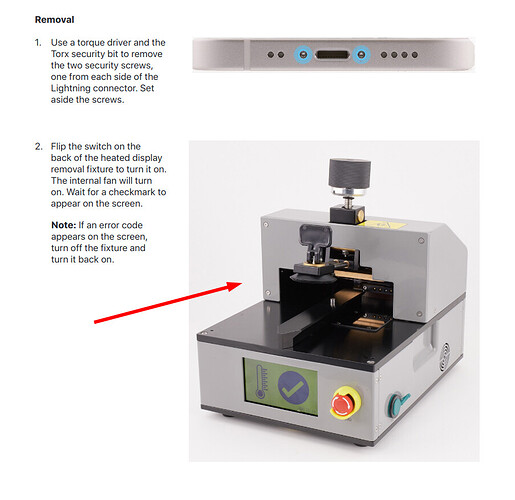It eventually happened (in the US):
And iFixit’s analysis: https://www.ifixit.com/News/59239/apples-self-repair-vision-is-here-and-its-got-a-catch
Good spot Panda!
As with most manufacturer-led repair schemes, I’m getting mixed messages here. Much of these seems pretty positive at first glance: official parts & tools for DIY repairs is great, even if it’s just for a small selection of products and just in the USA for now. But requiring an IMEI number does seem concerning.
I think the iFixit article you posted summarises this well:
Integrating a serial number check into their checkout process is a dire omen and could allow Apple the power to block even more repairs in the future. Building the technology to provision individual repairs easily sets Apple up as the gateway to approve—or deny—any repairs in the future, with parts from any source.
The pricing is interesting. In their press release, Apple say:
The parts are the same ones — at the same price — as those available to Apple’s network of authorized repair providers.
Here are the prices for their iPhone display and battery replacement kits:
 $213 - $312 for an iPhone display repair kit (depending on the model)
$213 - $312 for an iPhone display repair kit (depending on the model) $71 for an iPhone battery repair kit
$71 for an iPhone battery repair kit
What does everyone make of those?
According to the manual … you’ll need to rent one of these (heated display removal fixture) to change your phone display.
And for replacing the battery you should order ‘Clean, dry, untreated sand’! (It is good though to give some safety advice about dealing with batteries.)
I’m wondering whether the requirement for an IMEI also means that the device’s user will be able to check what parts have been ordered and installed. This would mean that when getting a device repaired by a third party, it would allow for far greater transparency and one would be able to find out if a genuine part has been used. Also having a published tariff for parts means that the cost of parts and labour will be clearly identifiable. If this happens, this increased transparency could help increase trust in (some) third-party repairers.
More on this from the fantastic Jessa Jones:
In summary…
To perform a display replacement on her iPhone 12 Pro, Jessa ordered a display replacement kit ($269) and rented the toolkit ($50) for a total of $319 - that compares to $279 to pay Apple to perform the display replacement themselves.
Worryingly, Jessa then shares that she had to pair the new display to her phone and in so doing had to agree to some pretty invasive terms & conditions, allowing Apple and its partners access to all kinds of usage data (including data about connected peripherals, app usage, call duration etc.)
Jessa is amazing. I interviewed her last year & she is a phenomenal person.
A video and article of a non-techie using the Apple kit to replace a battery and the difficulties he encounters:
Browsing through a few of the comments I noticed:
You do not need a 20 lb display heater when an electric heated blanket will do the job.
and wonder whether if the heat of an electric blanket is enough to soften the glue holding screens it would make sense to add a small one to repair kits.
On a the same note, SnazzyLabs filmed a screen replacement using the full Apple toolkit:
(for anyone else unfamiliar with imperial measurements, 97 lbs is 44 kg)
The bit I found most interesting/OTT was the step where he had to phone Apple, who remotely accessed his phone to start diagnostics mode and disabled the display and battery warning messages (see from 26:33)
Another article on the impracticality of the repair kit, and the issues with the part pairing -
But I wasn’t done yet. The single most frustrating part of this process, after using Apple’s genuine parts and Apple’s genuine tools, was that my iPhone didn’t recognize the genuine battery as genuine. “Unknown Part,” flashed a warning. Apparently, that’s the case for almost all of these parts: you’re expected to dial up Apple’s third-party logistics company after the repair so they can validate the part for you. That’s a process that involves having an entirely separate computer and a Wi-Fi connection since you have to reboot your iPhone into diagnostics mode and give the company remote control. Which, of course, defeats a bunch of the reasons you’d repair your own device at home!
Their ultimate conclusion:
The more I think about it, the more I realize Apple’s Self-Service Repair program is the perfect way to make it look like the company supports right-to-repair policies without actually encouraging them at all.
Must admit, I liked the tools - but then I like repair tools.
There’s no doubt that this repair is unlikely to be carried out by home users, but I wonder how many repair shops will buy the kit - it’s the access to the parts and the validation system which is key.
I have to applaud (though only a small one) Apple for doing ‘something’. I like the custom-press templates for re-applying the adhesive but everything else proves that these things are a repair minefield. It’ll be interesting to see how (or, if) the scheme evolves.
Thanks for sharing David!
The European Campaign’s just released an official response to Apple’s programme too, quoting @ugo as saying:
Basically, this move by Apple aims to promote a vision of repair where the manufacturer almost completely retains control on the product, setting high prices for parts, scaring consumers away from self-repair, while using software to limit use of third-party spares as well as the reuse of existing parts. This is far from the Right to Repair we need.
More here:


